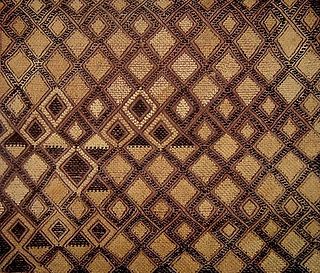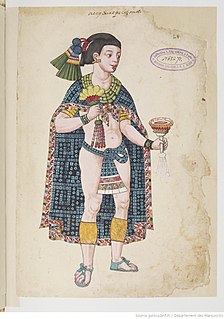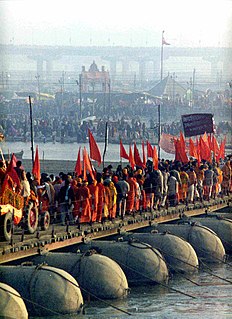
Garam masala from garam ("hot") and masala is a blend of ground spices, originating from the Indian subcontinent, common in cuisines from the Indian subcontinent, Mauritius and South Africa. It is used alone or with other seasonings. The word garam refers to "heating the body" in the Ayurvedic sense of the word, as these spices are believed to elevate body temperature in Ayurvedic medicine. There are other types of masala, like tikka masala and tandoori masala.

Ayurveda is a system of medicine with historical roots in the Indian subcontinent. Globalized and modernized practices derived from Ayurveda traditions are a type of alternative medicine. In countries beyond India, Ayurvedic therapies and practices have been integrated in general wellness applications and in some cases in medical use.

A G-string is a type of thong, a narrow piece of fabric, leather, or satin that covers or holds the genitals, passes between the buttocks, and is attached to a waistband around the hips. A G-string can be worn both by men and by women. It may also be worn in swimwear, where it may serve as a bikini bottom, but may be worn alone as a monokini or topless swimsuit. G-strings may also be worn by exotic or go-go dancers. As underwear, a G-string may be worn in preference to panties to avoid creation of a visible panty line, or to briefs in order to enhance sex-appeal.

The dhoti, also known as panche, vesti, dhuti, mardani, chaadra, dhotar, panchey, is a traditional men's garment worn in the Indian subcontinent. It is a rectangular piece of unstitched cloth, usually around 4.5 metres (15 ft) long, wrapped around the waist and the legs and knotted at the waist.
Oni (鬼) are a kind of yōkai, supernatural demon, devils, ogre, or troll in Japanese folklore. They are typically portrayed as hulking figures with one or more horns growing out of their heads. Stereotypically, they are conceived of as red, blue or green-colored, wearing loincloths of tiger pelt, and carrying iron kanabō clubs.

The lungi is a type of sarong, originating from the Indian subcontinent, and a traditional garment worn around the waist in Sri Lanka, India, Bangladesh, Pakistan, Nepal, Cambodia, Myanmar and Thailand. It is particularly popular in regions where the heat and humidity create an unpleasant climate for trousers.

Fundoshi(褌, ふんどし) is the traditional Japanese undergarment for adult males, made from a length of cotton. Before World War II, the fundoshi was the main form of underwear for Japanese adult males. However it fell out of use quickly after the war with the introduction of new underwear to the Japanese market, such as briefs and boxer briefs.

Shitagi, a type of shirt worn by the Samurai class of feudal Japan when they were wearing full armour. The shitagi was the second garment to be put on, coming second only to the Fundoshi. The shitagi was like a short kimono with a button at the neck and a thin attached waist cord (obi). There are several different types of shitagi. The shitagi would be put on as though it were a kimono, the left hand being put first into its sleeve, and then the right, the neck would then buttoned and the waist cord finally tied at the back.

Velours du Kasaï is a kind of textile fabric made in Kasai, a province in the Democratic Republic of the Congo (Zaïre). Traditionally, the weaving is done by men of the Shoowa from the Kuba ethnic group, while the embroidery is reserved to women. Ideally, the embroiderers should be pregnant. The technique is still practised.

The Ashvins or Ashwini Kumaras, in Hindu mythology, are twin Vedic gods of medicine. They are also described as divine twin horsemen in the Rigveda. They are the sons of Surya and his wife Saranyu, a goddess of the clouds.

The Alune people are one of the more ancient ethnic groups of Seram Island, Indonesia. They number about 21,300 and live in 27 villages of the western-central area of the island. Like the Wemale, they originated in a common group called Patasiwa.

Undergarments are items of clothing worn beneath outer clothes, usually in direct contact with the skin, although they may comprise more than a single layer. They serve to keep outer garments from being soiled or damaged by bodily excretions, to lessen the friction of outerwear against the skin, to shape the body, and to provide concealment or support for parts of it. In cold weather, long underwear is sometimes worn to provide additional warmth. Special types of undergarments have religious significance. Some items of clothing are designed as undergarments, while others, such as T-shirts and certain types of shorts, are appropriate both as undergarments and as outer clothing. If made of suitable material or textile, some undergarments can serve as nightwear or swimsuits, and some are intended for sexual attraction or visual appeal.

The thong is a garment generally worn as either underwear or as a swimsuit in some countries. It may also be worn for traditional ceremonies or competitions.

Tulasana, Balance Pose, Dolasana, Tolasana, or Utthita Padmasana is a hand-balancing asana in modern yoga as exercise.
Mansagari is a popular classical treatise on Hindu predictive astrology. It is written in the usual poetic form in the traditional Sanskrit Sloka format; the language and the method of expression used are both simple and unambiguous, and therefore, easy to understand. Its author, Janardan Harji, about whom not much is known, was the son of Janardan, of Gurjar Mandala, who belonged to the Shandilya Gotra, who was also a learned and renowned astrologer of his time and place. This text, comprising five chapters, covers briefly the essential parts of Ganitha and Siddhanta, but deals with the Phalita portion of Hindu astrology in far greater detail. It has described numerous yogas and Raja yogas and also narrated their effects, as also the results of the planetary dashas as all major dasha systems in vogue. Along with the more renowned works of Parashara and Varahamihira, Mansagari has remained a standard reference book. The book, Three Hundred Important Combinations, was written by Bangalore Venkata Raman on the basis of Jataka Tantra, Parashara Hora Sastra and Mansagari.

Yatan is a village in Kuhpayeh Rural District, Nowbaran District, Saveh County, Markazi Province, Iran. At the 2006 census, its population was 764, in 218 families.

Ghazyatan is a village in Razan Rural District, in the Central District of Razan County, Hamadan Province, Iran. At the 2006 census, its population was 160, in 48 families.

















